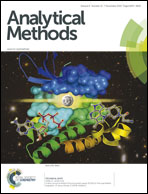Chemiluminescent assay of phenol in wastewater using HRP-catalysed luminol oxidation with and without enhancers
Abstract
Two methods for phenol determination based on the suppression of chemiluminescence (CL) produced upon HRP-catalysed oxidation of luminol were developed. One method used an enhanced CL reaction with 3-(10′-phenothiazinyl)-propane-1-sulfonate and 4-morpholinopyridine as primary and secondary enhancers, respectively, and another one is free of the enhancers. A comparison of the phenol assay with enhancers showed much higher sensitivity and lower LDL value than the assay without enhancers. In addition, the amount of HRP used in the assay with enhancers is 40 times less than in the assay without them. The study of the specificity of the developed assays demonstrated that in the assay without enhancers several phenol compounds, for instance, unsubstituted phenol, suppressed the CL intensity, whereas other phenols, such as 4-chlorophenol and 2,4-dichlorophenol, increased the light output. In contrast to that assay, in the assay with enhancers all tested phenols suppressed the CL intensity. Upon the analysis of phenols in the water plant effluents using the assay without the enhancers, a high matrix effect was observed. On the other hand, the analysis of the same effluents using the assay with enhancers did not show any matrix effect, and the recovery values from the spiked samples were found to be 92–96%.


 Please wait while we load your content...
Please wait while we load your content...